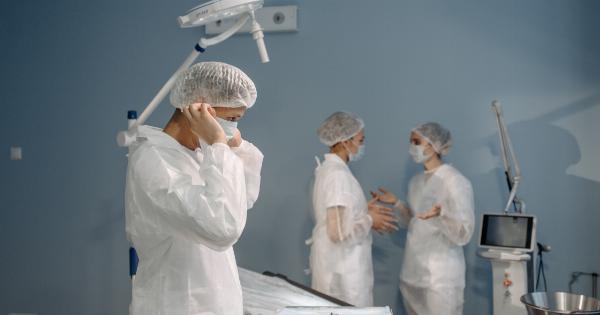Caesarean delivery, also commonly known as C-section, is a surgical procedure aimed at delivering a baby through incisions made in a woman’s abdomen and uterus.
This method of delivery has become increasingly popular in recent years, with reports indicating that approximately one in three babies in the United States is born via C-section.
The decision to undergo a C-section can be a difficult one and is typically made after weighing up the risks and benefits associated with both natural delivery and surgical intervention.
While there are certainly some risks associated with C-sections, such as infection and bleeding, there are also many benefits that cannot be overlooked:.
1. Reduced Risk of Birth Trauma
One of the most significant benefits of opting for a C-section is the reduced risk of birth trauma.
Natural delivery can be a very traumatic experience for both the mother and the baby, with the baby needing to travel through the birth canal amidst contractions and pressure from the surrounding tissues. This can sometimes lead to injuries such as shoulder dystocia or brain damage. By opting for a Caesarean delivery, the baby is delivered through a carefully controlled incision, meaning that there is far less risk of injury.
2. Eliminating the Risk of Vaginal Tears
During natural delivery, vaginal tears often occur due to the large size of the baby’s head or shoulders as they pass through the birth canal.
While these tears are usually minor and heal quickly, they can sometimes require surgery and can cause significant pain and discomfort for the mother. By opting for a C-section, the risk of vaginal tears is eliminated entirely, making for a much more comfortable postpartum recovery for the mother.
3. Faster Recovery Time
While C-sections are a surgical procedure, recovery time is often faster compared to natural births. This is because a Caesarean delivery is a planned procedure, and there are no surprises during delivery that can cause trauma and injury.
Additionally, C-sections are typically shorter than natural deliveries, and since the mother is not pushing during delivery, there is less strain on the body. Overall, many mothers find that they experience less pain and have a quicker recovery after a C-section compared to a natural birth.
4. Lower Chance of Incontinence
Another benefit of undergoing a C-section is a lower risk of developing incontinence. During natural delivery, the muscles and tissues of the pelvic floor can become damaged due to the pressure and strain placed on them during delivery.
This can result in urinary and fecal incontinence, which can be a chronic and debilitating condition. By undergoing a C-section, the risk of developing incontinence is significantly reduced, preserving the mother’s quality of life.
5. Control Over Timing of Delivery
One of the primary benefits of a planned C-section is that the mother has much greater control over the timing of delivery. With natural births, labor can occur at any time, and there is often unpredictability around when the baby will arrive.
This can be a cause of anxiety for many mothers, making it difficult to plan or prepare for the delivery. With a C-section, however, the mother knows exactly when the delivery will occur, making it easier to plan and ensure that family members, support systems, and healthcare providers are available when needed.
6. Reduced Risk of Postpartum Depression
Postpartum depression (PPD) is a common and serious condition that affects many new mothers. While there is no one definitive cause of PPD, it is thought to be linked to the hormonal changes and stress of childbirth.
Women who have undergone a C-section, however, may be at a lower risk of developing PPD, simply because they have had a less traumatic and stressful birth experience. This can be especially important for mothers who may already be at higher risk for PPD, such as those who have a history of depression.
7. Reduced Risk of Transmission of Certain Infections
In some cases, a C-section may be recommended to reduce the risk of transmission of certain infectious diseases.
For example, mothers with HIV, hepatitis B, or herpes simplex virus may be advised to undergo a Caesarean delivery to reduce the risk of transmitting the infection to the baby during delivery. While this is certainly not the case for all infectious diseases, opting for a C-section in these situations can be an important way to protect the health of the baby.
8. Emergency Backup Plan
In some cases, a natural delivery may be attempted but may not be possible due to complications or unforeseen circumstances. In these situations, having a C-section as a backup plan can be a lifesaving option.
This is especially important for mothers who may have underlying health conditions, such as heart disease or diabetes, that make natural delivery more risky. Having a C-section as a backup option can give mothers and healthcare providers peace of mind, knowing that there is a safe and effective option available if needed.
9. Lower Risk of Uterine Prolapse
Uterine prolapse is a condition where the uterus drops or descends from its position in the pelvis, causing pain, discomfort, and incontinence.
This condition is most commonly seen in women who have undergone natural childbirth, due to the strain placed on the pelvic floor muscles during delivery. By opting for a C-section, the risk of uterine prolapse is significantly reduced, preserving the mother’s long-term health and comfort.
10. Choice and Autonomy
Finally, one of the most important benefits of opting for a C-section is the choice and autonomy that it gives the mother.
While natural delivery is still the most common method of delivery, it is important for women to have the option to choose a C-section if it is right for them. This allows women to make informed decisions about their health and the health of their baby, and can provide a greater sense of control and empowerment during the birth experience.
Conclusion
While there are certainly risks associated with Caesarean delivery, it is important to remember that there are also many benefits.
From reducing the risk of birth trauma to faster recovery times, greater control over timing, and the preservation of long-term health, C-sections can be a safe and effective way to deliver a healthy baby. For mothers who are unsure about whether to opt for a C-section or natural delivery, it is always important to speak to a qualified healthcare provider and weigh up the risks and benefits for their individual situation.




























